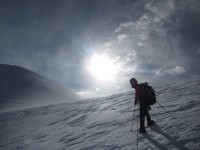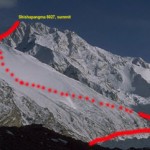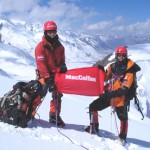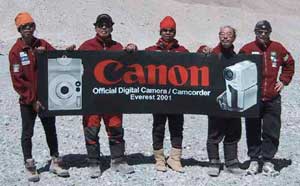Everest North Col Breakthrough
Dear Friends,
A special hello to Muna, Steve Wong, the Simons, Fatoma, Anna and Daniel from Essex and Sue Fuller – all armchair fans of our adventures. Please surf to http://www.everest.org.sg for the pictures and updates.
Gil and I returned from the North Col yesterday. We had been away from the relative warmth and comforts of Basecamp for 9 days. As you might have read, the team left BC on April 18th for a key acclimatisation climb to the North Col.
This snowy saddle is central to all attempts on the summit. From Advance Base Camp (ABC) the idea is to make a carry to the Col (7,000m), followed by a subsequent attempt to sleep one or more nights on the Col. In high altitude climbing, it is critical to be able to gradually work our way up, climbing and sleeping at progressively steeper altitudes until the top camp – from where a summit climb can be made. This is all still some time ahead of us. The recent dramatic evacuation of a Kuwaiti climber to Kathmandu from cerebral edema underlines how serious the issues of acclimatisation (or lack of it thereof) can be.
After reaching ABC on the 19th, we decided on a rest day (the 20th). Rozani’s account of the carry to North Col can be found in the recent website reports. The 22nd was designated yet another rest day. However, by this stage, both Beng Cheong and Roz had had some upper respiratory tract infections which was not just bothersome, but necessitated a descent to Basecamp. While upsetting our schedule of acclimatisation, we still had bags of time in the greater scheme of things.
On the 23rd, Gil and I decided on making the big push to the North Col. The 500m high ice and snow face is threatened in a few places by overhanging ice but not significantly so. After an hour-long approach to the base of the 50 degree face, we began our ascent, using the previously laid fixed rope as security. While normally providing some exhilarating climbing up to see some great views, the climb was difficult for me, especially with my disabled right ankle. The sustained and constant rotation of the cramponed boot to enable as many of the steel spikes attached to the heavy plastic boot to make contact with the snow was a big challenge. We were also carrying a load up to the North Col which made the altitude a tough addition to our problems. Some steeper sections were about 70 degrees steep. Six hours later and an hour after Gil, I made it to the campsite, a collection of about 15 tents huddled under a protective snow wall. We slept fitfully – as always, when at a new altitude. For Gil, this represented a personal altitude record not just in terms of the highest point to which he had ever climbed but also in terms of sleeping altitude.
The following morning, I slowly led the way up the north ridge. None of the books or videos I’ve seen can really project how impressive the north face of Everest really is. Once I turned the small corner, the massive sweep of the north face plunged down into the Central Rongbuk Glacier. looking up, I saw the wavy snow ridge that snaked up to merge in to the north face at about 7,900m. A steady wind screeching across from far west began hammering us. Also to the west, we could look down into Nepal, the most prominent peak being the inverted ice cream cone of Pumori (7,123m).
I yelled to myself aloud, “I can’t believe it! I’m actually climbing the north ridge!” Suddenly, it seemed like a year of preparation and a decade of merely thinking about this climb had become reality in an instant.
Our plan as not to climb very high that day but merely to log in more altitude time. After a couple of hours, Gil’s hands were becoming very cold and we decided to turn back, picking our way back to the camp. As the sun set that evening, casting an alpenglow over the striated rocky features of the north face, I kept looking up and wondering how those brave 1920s explorers could have even contemplated tackling this enormous route. From an emotional point of view, should I not return to complete this climb, just the memories of that fantastic morning on the north ridge will be enough to sustain me.
The following morning, we descended in the teeth of a bad weather front. As I clipped into the first rope to descend by rappel, I looked up at the black clouds shredding across the top half of Everest. Breakfast or no, this was no place or time to hang about. We spent half the day carefully descending the face on empty stomachs and then walking back to ABC with an unpleasant wind pumping snow in our faces.
Climbing to the Col, sleeping at 7,000m, and climbing above it represents a significant step for our team in terms of the overall progress-in-stages needed to climb this mountain. Personally, I’m not going fast, but climbing to the Col resolved some questions I had about my ability (or disability) to handle this sort of climbing as well as an affirmation of my belief that you also have to stay healthy to climb this mountain.
Some critical issues remain. The long trek up to ABC and the heightened risk of getting more infections/bugs and so on make multiple trips to ABC inadvisable, in my opinion. However, if a summit window/opportunity only seems likely in late May, Gil and I will have to go up once more to ‘top up’ on our acclimatisation. Roz and Beng Cheong are now one acclimatisation ‘cycle’ behind us so will have to go back to ABC and onwards to North Col to get that valuable ‘high’ under their belts prior to any summit push. How the two halves of our team will coordinate a summit climb in May is a matter open to discussion. It seems that mid-May is a possible period for summitting.
In the meantime, rest and recuperation and the key words… “the summit can wait”.
Ciao,
Dave Lim
Ola,
Estamos de volta ao Campo Base, lar doce lar, a 5.400m de altitude. Foram 9 dias, e 9 noites, em altitudes superiores a 6.000m. Esta foi a nossa terceira subida para trabalhos de aclimatacao em grandes altitudes no proprio Everest. Atingimos o acampamento 4, ou Colo Norte, a 7.100m de altitude onde “dormimos” duas noites. Este local, Colo Norte, como o proprio nome diz, eh o colo entre o Everest e o Changtse, uma pequena plataforma de gelo de uns 50m, protegida por uma cornija de gelo dos fortisssimos ventos que assolam este flanco do Everest. Partimos dia 18 de abril rumo ao campo 1 a 6.000m; dia seguinte atingimos o campo 3, ABC, a 6.600m onde ficamos por 4 noites. No meio destes dias fizemos uma escalada parcial ao Colo Norte, para conhecer a parede de gelo de 500m de desnivel ate o Colo Norte – imagem colocada no site – Dia 23 David e eu partimos para o Colo Norte, Rozani e Beng Cheong tiveram que voltar ao Base devido a problemas de saude (respiratorios). Aqui uma pausa – uma das maiores dificuldades eh tentar manter a saude sem problemas, especialmente o sistema respiratorio. Por ex. agora, estou com forte dor de garganta e com o pulmao congestionado devido ao ar extremamente seco e gelado…e vento, muito vento. Fazemos de tudo para manter aquecida a regiao da garganta…mas nao dah mesmo. Espero que os dias que ficarmos aqui no Base melhorem a nossa situacao de saude. Bem, este nao eh um problema exclusivo nosso….o som que mais se escuta por aqui eh a tosse.
Voltando, David e eu escalamos a parede do Colo Norte….maravilhosa…puro gelo e um visual magnifico do Everest, do Glaciar de Rongbuck e a companhia de escaladores de diversas partes do mundo. Quando parei numa plataforma para descansar um senhor me ofereceu chah, eu aceitei, ele eh da Siberia. Ficamos duas noites acampados no Colo…nao foi muito facil dormir, comer (quase nao comemos) a 7.100m…e ainda faltam 1750m para o cume. O dia que descemos para o ABC tivemos muito azar pois pegamos um dos piores dias com ventos fortissimos e tempestade de neve. Isto aliado ao nosso desgaste fisico de tantos dias de esforco. Para se ter uma ideia, comparando com os Andes, “nestes 9 dias escalamos duas vezes o Aconcagua e dormimos duas noites no seu cume”. O acampamento 3, ou Acampamento Base Avancado, ABC, a 6.600m, eh uma pequena cidade de barracas. Ateh que temos algum conforto, uma pequenina barraca para dormir e uma barraca maior para refeicoes. Soh que a vida aqui eh ficar dentro das barracas devido ao frio e vento. Por ex. do lado de minha barraca, ah uns dez metros, em um expedicao internacional, tinha um casal de brasileiros (Paulo e Helena), que eu nem vi nem fiquei sabendo por lah; vim a saber somente quando voltava para cah e numa das paradas de descanso acabei encontrando o lider daquela expedicao. Paulo e Helena ainda estao por lah….toda a sorte e sucesso para eles. Bem, do que eu sei, da America do Sul tem duas expedicoes – uma Colombiana e outra da Venezuela…..com estes eu conversei.
Bem pessoal vou ficando por aqui. Jah fizemos 3 subidas e na proxima sera para ir ao cume, se Deus quiser. Vamos descansar aqui no Base ate recuperar a forca a saude e…engordar um pouco 🙂 acho que nestas perdemos alguns quilinhos. Torcam por nos, mas sobretudo rezem pela nossa seguranca.
Abracos,
Gil

































